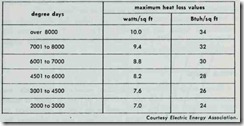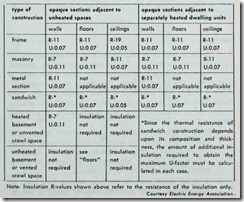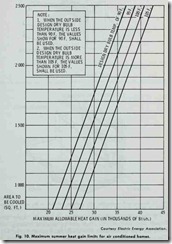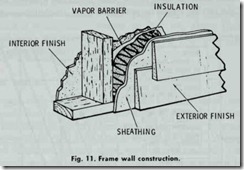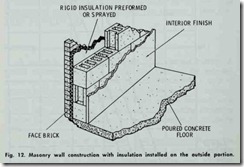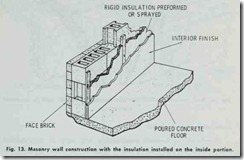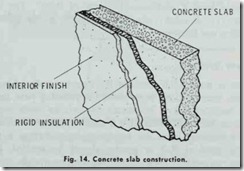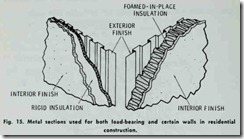INSULATION FOR ELECTRICALLY HEATED AND COOLED STRUCTURES
Any structure electrically heated and cooled must be properly insulated or operation costs will be unacceptable. Converting an older structure to electric heat is therefore not recommended unless you have no objection to the additional expense of im proving the insulation, or you feel you can live with the higher operating costs. Consequently, electric heating is more often considered for new construction.
Insulating a structure that is to be electrically heated and cooled requires greater attention to construction details than do other types of systems; however, the results are well worth the effort because reduced operating costs and other gains (e.g. the reduction of outside noise, quiet operating characteristics, etc.) are soon readily apparent. Because electric heating and cooling systems require an especially well-insulated structure for efficient operation, recommendations for the required minimum levels of insulation are included in this chapter. These recommendations are based on information included in the Electric Energy Associa tion’s publication “Electric Space Conditioning in Residential Structures”.
The recommendations found in the following paragraphs will contain references to U-factors and R-values. The U-factor is the overall coefficient of heat transfer and is expressed in Btu’s per hour per square foot of surface per degree Fahrenheit differ ence between air on the inside and air on the outside of a struc tural section. The R-value, on the other hand, is the term used to express thermal resistance of the insulation. The U-factor is the reciprocal of the sum of the thermal resistance values (i.e. R values) of each element of the structural section. Table 1 gives the insulation recommendations for electrically heated and cooled structures both in terms of R-values and overall coefficients of heat transfer in terms of U-factors.
Table 2 lists heat loss limits for electrically heated structures as recommended by the Electric Energy Association. The values
Table 1. Maximum winter heat loss for electrically heated homes.
Table 2. Insulation recommendations (R-values) and overall coefficients of heat transfer (U-factors) for maior areas of heat loss and heat gain in residential structures.
listed are expressed in watts and Btuh’s (1 watt equals 3.413 Btuh) per square foot of floor space measured to the exterior walls. The assumed infiltration rate on which this table is based is approximately three-quarters air change per hour.
The maximum summer heat gain limits for electrically air conditioned homes are indicated in Fig. 10. These figures are adapted from the FHA Minimum Property Standards for single family and multifamily structures.
Frame Walls
Frame walls (Fig. 11) , with either wood or metal studs, are commonly insulated with rolls and batts of mineral, glass or wood fiber insulation material. More and more use of sprayed-on or foamed-in-place rigid insulation is also being made. Whatever the type of insulation decided upon, exterior opaque walls and walls between separately heated units should have a maximum U-factor of 0.007, which will require insulation rated at R-11 or greater. A thermal resistance of R-11 can be provided by 3lh-inch fiber batts or other equally suitable materials (see Chapter 3. INSULA TION PRINCIPLES).
Masonry
A masonry wall is a particularly poor thermal barrier. A typical masonry cavity wall ( 4-inch face brick on the exterior, an air space, 4-inch concrete block, an air space, and a layer of gypsum wall board) has a thermal resistance equal to approxi mately 1 inch of rigid insulation. Exterior opaque masonry walls should have a maximum U-factor of 0.11 requiring insulation rated at R-7 or greater. This can be accomplished in the following ways:
1. Place a layer of preformed rigid insulation between the exterior face brick (or other finishing material) and the concrete block during construction (Fig. 12). Another method is to leave the space empty and then to fill it with a foam insulation before capping the wall.
2. If no air space exists between the exterior face brick or other exterior finish and the concrete block, it will be necessary to add a layer of suitable insulating material (rated R-7 or better) on the inside surface of the block (Fig. 13). The insulating material can be rigid insulation attached to furring strips, foam insulation sprayed between the furring strips, or preformed rigid insulation secured in place with adhesives. An interior wall finish is then applied over the insulating material.
If the wall is constructed entirely of concrete, apply pre formed rigid insulation to either side by adhesive bonding, and cover the layer of insulation with a wall finish material (Fig. 14). The insulation must be rated R-7 or better.
Metal
Exterior opaque metal walls (Fig. 15) should have a maxi mum U-factor of 0.07. This will require insulation having a thermal resistance rated at R-11 or bettter , which can be pro vided by a layer of rigid insulation either preformed or foamed in place.
Sc: ndwich Construction
Sandwich or layered construction will vary in composition and thickness, but will typically consist of three layers: two facings and a core. Exterior opaque walls of a sandwich construc tion should have a maximum U-factor of 0.007. The thermal resistance (i.e. R-value) must be calculated on the basis of its composition and thickness.
Basement Walls
There is no need to insulate the exterior walls of unheated basements because there is no need for reducing heat loss. The exterior walls of heated basements (or interior wa11s separating heated from unheated areas) are a different matter, because heat loss is a concern here. An insulating layer having a thermal resistance rated at R-7 or greater should be applied. Fig. 16 illustrates two methods for insulating these types of walls.
